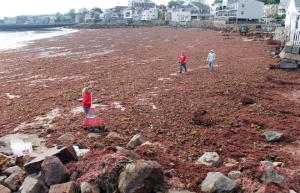Seaweed wreaks havoc in many coastal communities around world. Is it a growing threat in Long Island Sound?

When most people think of algae blooms, which are rapid increases in algal biomass, something like green slime or pond scum is what usually comes to mind. Often unsightly, and sometimes even dangerous, algal blooms are making more news as we learn more about their implications for human and ecosystem health. Most stories focus on blooms of phytoplankton that cause outbreaks of amnesiac or paralytic shellfish poisonings, red tide (associated with a certain dinoflagellate and not, as is popularly assumed, red algae) or events like the recent cyanobacterial bloom in Lake Erie. Also very common, but usually receiving less attention are blooms of macroalgae, which you know as seaweeds.
Seaweed blooms are caused for the most part by the same factors as their smaller, microalgal cousins: increases in light availability, temperatures and nutrient levels; though these events can occur naturally, they are increasingly the result of human activity. Seaweed blooms are obviously a nuisance to recreational beach users, where washed up algae often rot, attracting insects and emitting noxious odors. They can have more far-reaching effects such as contributing to hypoxia, outcompeting native seaweeds other local organisms, and emitting of noxious fumes. In 2009 a horse famously died on a “green tide” covered beach in France after inhaling an excess of hydrogen sulfide (H2S), a byproduct of seaweed decomposition; two years later nearly three dozen wild boars succumbed to H2S poisoning a few miles away.
Since 2007, the coast of Qingdao, China has seen increasingly massive blooms of Ulva—commonly known as sea lettuce. Last year’s bloom was spread over 11,000 miles and represents the largest macroalgal bloom on record (for reference, that’s about twice the size of Connecticut). This blog’s cover photo shows Qingdao’s bloom in 2013. Tractors were later used to clear away the sometimes waist-deep accumulations. More photos here.
Biologists believe these green tides form about 125 miles south of Qingdao, as an unintended result of large-scale nori farming. Beaches in Hawaii and Florida, where nutrient levels are naturally relatively low, have been experiencing severe red seaweed bloom events since the 1970s, a result of wastewater mismanagement and ill-conceived civil engineering pulling millions in lost tourism dollars and cleanup costs out of the economy.
There is at least one possible benefit to seaweed blooms: removal of toxins from nearshore areas. Donald Cheney of the University of New Hampshire has been studying algal blooms in New Bedford Harbor, MA, a Superfund site, for several years. He’s found that Ulva can accumulate PCBs in concentrations of greater than 30,000 times the level of the surrounding water. Ulva could potentially be used to remove PCBs from the water, but if these blooms remain unchecked they could pose a threat to human health. Sea lettuce is a principal dietary component of several shrimp and fish species that in turn are important to other species up the food chain, some of which are popular recreational fishery targets.

Although we are unlikely to see Qingdao-scale blooms in New England, several bloom forming seaweeds do inhabit, or have recently arrived in, Long Island Sound. Smaller scale green tides have become common in nitrified bays like New Haven Harbor, especially on hot sunny days. Two species new to the area, Gracilaria vermiculophylla, a stringy seaweed that has largely replaced the local species of Gracilaria, and Heterosiphonia japonica, a bright-red fluffy-looking plant are recent additions to local waters, having first been recorded in the last 4-7 years.
They haven’t formed what could be considered blooms in LIS, but they are considered invasive and have been observed to cause blooms in nearby regions of the East Coast. Warming ocean temperatures and coastal eutrophication may lead to increased chance for blooms and their accompanying side effects, especially in Long Island Sound and other vulnerable estuaries.
Posted by Ken Hamel, Research Intern for Save the Sound
Cover photo: http://www.socawarriors.net/forum/index.php?topic=59998.0

We’ve been studying algae proliferation in the Cape Cod area for several decades at the Lewis Bay Research Center and have witnessed similar trends. The shift to red-brown algae may be due to the effects of increased turbidity due to the presence of micro-algae in the upper water column causing light deprivation for bottom dwelling species. The natural ecosystem mechanisms utilize the algae bloom to deal with periodic or occasional excess nutrient conditions. The problem becomes a significant issue when the excess nutrient condition becomes systemic vs event based as in the case of the non-point source pollution scenario now commonplace proximal to our coastal communities worldwide.
Our research has shown that algae may be an important tool in reducing nutrients from discharge waters. Recent studies conducted in our Parker’s River laboratory photobioreactor to assess the ability of algae to polish wastewater by stripping out the nutrients have shown that algae can reclaim nitrogen and phosphorous from secondary wastewater, bringing nutrient discharges to near non-detect levels. It would appear that mother nature is on to something in the utilization of algae as a nutrient removal methodology. Unfortunately our communities nutrient discharges are overwhelming the system and creating the new problem exhibited in these massive algae blooms and the strange shifts in our local algae species.